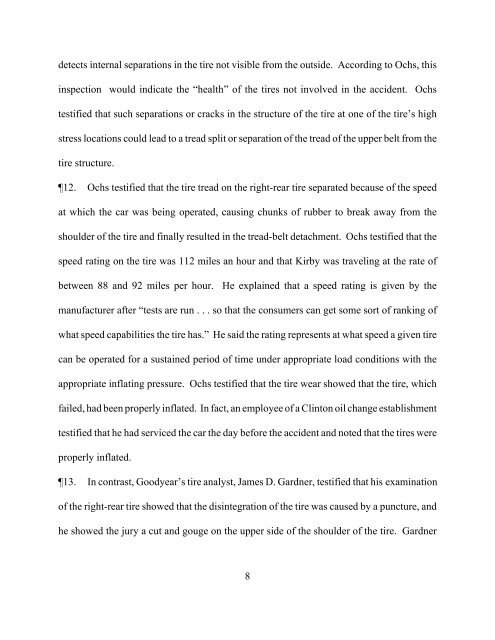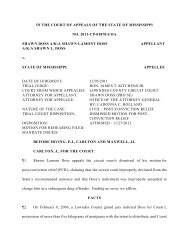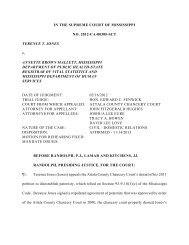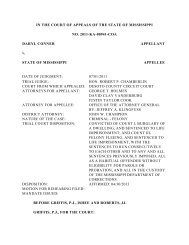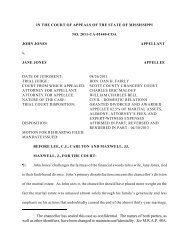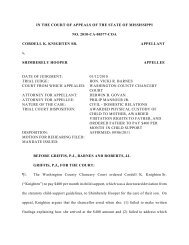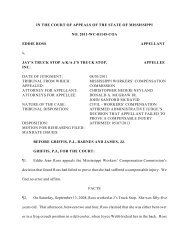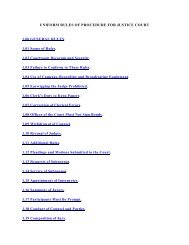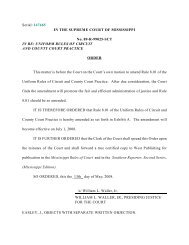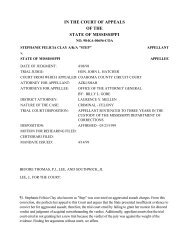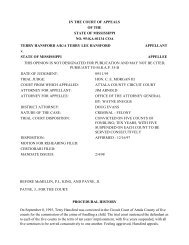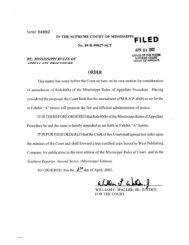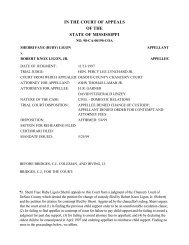in the court of appeals of the state - Mississippi Supreme Court
in the court of appeals of the state - Mississippi Supreme Court
in the court of appeals of the state - Mississippi Supreme Court
You also want an ePaper? Increase the reach of your titles
YUMPU automatically turns print PDFs into web optimized ePapers that Google loves.
detects <strong>in</strong>ternal separations <strong>in</strong> <strong>the</strong> tire not visible from <strong>the</strong> outside. Accord<strong>in</strong>g to Ochs, this<br />
<strong>in</strong>spection would <strong>in</strong>dicate <strong>the</strong> “health” <strong>of</strong> <strong>the</strong> tires not <strong>in</strong>volved <strong>in</strong> <strong>the</strong> accident. Ochs<br />
testified that such separations or cracks <strong>in</strong> <strong>the</strong> structure <strong>of</strong> <strong>the</strong> tire at one <strong>of</strong> <strong>the</strong> tire’s high<br />
stress locations could lead to a tread split or separation <strong>of</strong> <strong>the</strong> tread <strong>of</strong> <strong>the</strong> upper belt from <strong>the</strong><br />
tire structure.<br />
12. Ochs testified that <strong>the</strong> tire tread on <strong>the</strong> right-rear tire separated because <strong>of</strong> <strong>the</strong> speed<br />
at which <strong>the</strong> car was be<strong>in</strong>g operated, caus<strong>in</strong>g chunks <strong>of</strong> rubber to break away from <strong>the</strong><br />
shoulder <strong>of</strong> <strong>the</strong> tire and f<strong>in</strong>ally resulted <strong>in</strong> <strong>the</strong> tread-belt detachment. Ochs testified that <strong>the</strong><br />
speed rat<strong>in</strong>g on <strong>the</strong> tire was 112 miles an hour and that Kirby was travel<strong>in</strong>g at <strong>the</strong> rate <strong>of</strong><br />
between 88 and 92 miles per hour. He expla<strong>in</strong>ed that a speed rat<strong>in</strong>g is given by <strong>the</strong><br />
manufacturer after “tests are run . . . so that <strong>the</strong> consumers can get some sort <strong>of</strong> rank<strong>in</strong>g <strong>of</strong><br />
what speed capabilities <strong>the</strong> tire has.” He said <strong>the</strong> rat<strong>in</strong>g represents at what speed a given tire<br />
can be operated for a susta<strong>in</strong>ed period <strong>of</strong> time under appropriate load conditions with <strong>the</strong><br />
appropriate <strong>in</strong>flat<strong>in</strong>g pressure. Ochs testified that <strong>the</strong> tire wear showed that <strong>the</strong> tire, which<br />
failed, had been properly <strong>in</strong>flated. In fact, an employee <strong>of</strong> a Cl<strong>in</strong>ton oil change establishment<br />
testified that he had serviced <strong>the</strong> car <strong>the</strong> day before <strong>the</strong> accident and noted that <strong>the</strong> tires were<br />
properly <strong>in</strong>flated.<br />
13. In contrast, Goodyear’s tire analyst, James D. Gardner, testified that his exam<strong>in</strong>ation<br />
<strong>of</strong> <strong>the</strong> right-rear tire showed that <strong>the</strong> dis<strong>in</strong>tegration <strong>of</strong> <strong>the</strong> tire was caused by a puncture, and<br />
he showed <strong>the</strong> jury a cut and gouge on <strong>the</strong> upper side <strong>of</strong> <strong>the</strong> shoulder <strong>of</strong> <strong>the</strong> tire. Gardner<br />
8


